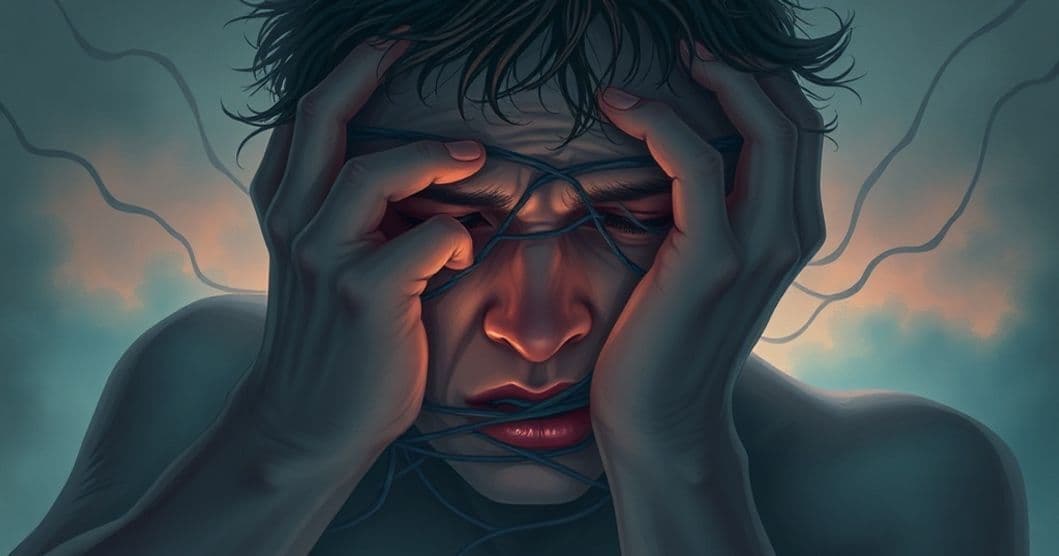Part 1: Dream Presentation
Dreams often serve as windows into our emotional landscapes, and this particular night vision reveals a tangled web of anxiety that manifests in physical and psychological torment. I wake at 3am, and the strangling anxiety returns—a physical pressure that squeezes my chest and steals my breath. It’s not just a dream anymore; it’s a living nightmare wrapping around me like a noose, heavy arms pinning me to the mattress, my mind tangled in thoughts I can’t untangle. For weeks now, this has been my ritual: at precisely 3am, the same suffocating feeling materializes, a reminder that something in my body or mind is profoundly out of balance. I’ve always been a light sleeper, but these nights feel different—more like being trapped in a psychological vise. The 'demon' I sense isn’t a literal creature, but a weight, a presence of unease that lodges in my chest as I try to sleep. Each time I drift back, I’m jolted awake moments later, sweating in both hot and cold waves, my stomach twisting with nausea and my chest still tight from that invisible strangulation. It’s exhausting, this cycle of near-sleep and abrupt terror. I’ve been meaning to call the doctor for weeks, ever since I first noticed this pattern, but the anxiety itself seems to strangle even that simple act of reaching out. I lie there, tired and frustrated, wondering why our minds and bodies feel so disconnected yet so intertwined—why the engine of my mind can so easily derail my body’s need for rest. It’s a strange, uncomfortable truth: we’re both victims and architects of our own psychological storms.
Part 2: Clinical Analysis
Symbolic Landscape: The Strangler and the 3am Demon
Want a More Personalized Interpretation?
Get your own AI-powered dream analysis tailored specifically to your dream
🔮Try Dream Analysis FreeThe dream’s central symbol—the 'strangling' anxiety—represents psychological suffocation, a common manifestation of repressed emotions or unprocessed stress. In dreamwork, physical sensations of choking often reflect feelings of being overwhelmed by external pressures or internal conflicts. The 'demon' imagery isn’t literal but an archetypal representation of the dreamer’s internalized fears: a non-human, non-specific entity that embodies the abstract nature of anxiety. The 3am timing is particularly significant, as this liminal hour (between deep sleep and morning) often correlates with heightened emotional processing in the unconscious mind. Jungian psychology notes that dreams during this period frequently address unresolved issues needing attention, while the 'heavy arms and heavy mind' describe a physical manifestation of mental overload—our bodies mirroring our psychological burdens.
Psychological Perspectives: From Freud to Neuroscience
Freudian theory might interpret this as an anxiety dream, where unconscious conflicts manifest symbolically to avoid conscious awareness. The 'demon' could represent repressed childhood fears or unacknowledged trauma, while the physical symptoms (strangulation, nausea) reflect the id’s demands clashing with the ego’s defenses. Jungian analysis, however, views the 'demon' as a shadow aspect—the dreamer’s own unintegrated anxieties brought into awareness. From a modern neuroscience lens, this aligns with REM sleep disruption and hyperarousal during anxiety states, where the brain’s threat-detection system (amygdala) remains overactive, triggering fragmented sleep patterns and vivid, terror-filled dreams. The mind-body connection here is bidirectional: stress disrupts sleep, and poor sleep exacerbates anxiety, creating a self-reinforcing cycle.
Emotional & Life Context: Unresolved Tensions
The recurring nature of the dream suggests persistent psychological stressors that haven’t been addressed. The 'constant reminder to call the doctor' hints at health anxiety or physical symptoms (possibly chronic pain or undiagnosed conditions) that the dreamer fears or avoids confronting. The frustration with 'venting writings' and the 'fog of tieredness' indicate sleep deprivation worsening emotional regulation, creating a cycle of exhaustion and anxiety. This pattern often occurs during periods of life transition, work pressure, or relationship stress, where the mind fixates on unmet needs or unresolved conflicts. The dream acts as a signal: the body and mind are signaling that something must change before the anxiety fully overwhelms daily functioning.
Therapeutic Insights: Breaking the Cycle
For the dreamer, this nightmare offers an opportunity to address both physical and psychological dimensions of anxiety. First, prioritizing sleep hygiene—consistent bedtime routines, limiting screen time before bed, and creating a calming pre-sleep ritual—can disrupt the hyperarousal cycle. Journaling about the dream’s details (especially the 'demon’’s appearance and context) helps externalize anxiety, reducing its power. The act of 'calling the doctor' mentioned in the dream should be literalized: addressing potential physical causes (like sleep apnea or thyroid issues) alongside psychological ones. Grounding techniques during 3am awakenings—such as progressive muscle relaxation or deep breathing—can interrupt the 'strangulation' sensation. Cognitive-behavioral therapy offers tools to reframe anxious thoughts, while mindfulness practices help differentiate between the dream’s emotional intensity and waking reality.
FAQ Section
Q: What does the 'strangling' sensation symbolize in this dream?
A: The physical choking represents feeling overwhelmed by internal or external pressures, often tied to unprocessed emotions or fears that feel inescapable.
Q: Why does the dream occur specifically at 3am?
A: 3am is a period of natural physiological transition (lower cortisol, REM sleep cycles), making the mind more vulnerable to emotional processing. Dreams at this hour often surface repressed concerns needing attention.
Q: How can I differentiate between normal anxiety and a potential sleep disorder?
A: Persistent 3am awakenings with physical symptoms (nausea, sweating) suggest a sleep-related anxiety cycle. Consult a healthcare provider to rule out conditions like sleep apnea, while journaling anxiety triggers helps identify psychological patterns.
